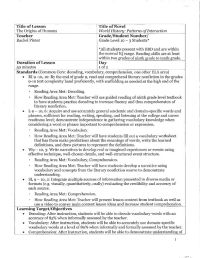Prompt: For this meta-reflection, please describe some of the big ideas or “take-aways” from this course. What have you learned the most about? What ideas have perhaps caused you to make changes to your practice or at the very least caused you to pause and reconsider some preconceptions you have had?
When reflecting on what I have learned the most about as a result of my completion of Learners in Context (EDU 6132), the most valuable set of information seems to be the various brain-friendly strategies from Medina’s Brain Rules. Exploring how the brain works and learns informs so much of what I do as an educator now, or at least enables me to examine my approach more objectively and critically. In particular, I feel that this information is exceedingly useful when working with students with emotional/behavioral disorder(s) at the high school level, because it serves as a strong reminder and guide for what and how these students can best learn. Rules ranging from stress to memory to attention to even gender have helped me improve my understanding of the strategies that will best promote learning when considering specially designed instruction.
For instance, learning about the impact of stress on cognition, ranging from memory to executive function, was a critical insight. Many of my students have stressful home lives beyond their control and then are expected to come to school and perform well. But the reality is that they cannot do so to their true abilities if they are stressed. Therefore, one change I have made to my practice is making subtle inquiries into their home life when I see a student struggling. If my probing reveals something, I have several potential steps. The first is to at least lessen the amount or intensity of work required for that period. Another is to provide breaks to talk about things. I feel like this is similar to one of my peers, who described a set of students experiencing high family stress. She stated that the teachers and staff were lessening stress on their end “by not asking too much of the [students] right now, and by keeping the classroom schedule and expectations as unchanged as possible.”
Another brain rule that has changed my practice and understanding is attention. Medina notes that the average person can only stay engaged to any one thing for about ten minute before needing a change. Since I work with many students with mild to severe ADD and ADHD, I have started having students work on one thing for seven to ten minutes before changing to another thing whenever I can. It does not always work as a practice—sometimes the reality is that a student must power through an assignment for a class because we simply won’t have time to complete it later. When I design lessons, I also limit direct instruction to about ten minutes. I also try to include more emotion to engage their attention, because within those ten minutes, I really want them to engage with the material I am attempting to impart.
Exploration is another brain rule that has really changed how I think about instructional planning. It served as an important reminder that having students sit in desks and learn about a specific topic for fifty minutes seven times a day is not an appropriate match with how our brain expects and has evolved to learn about the world. Students have innate curiosity about the world, but it can be difficult to maintain in the aforementioned set up. Therefore, incorporating field trips, walks out into the courtyard, or even just “what do you want to research today” projects to explore their interests really promote that curiosity and learning.
Overall, while I enjoyed learning about the various human development theories and other concepts in this course, it was the Brain Rules that seemed to capture my own interest and offer practical, research-driven methods for instructional strategies and planning.
E1 – Exemplify professionally-informed, growth-centered practice.
This reflection relates to HOPE principle E1 because learning about the various brain rules ultimately informs my practice and also me to grow as an emerging educator. Knowledge and understanding regarding the brain and how it impacts learning provides me with the ability to select teaching practices that attempt to harness the power of the brain rather than work against its nature. Due to this knowledge, I have more research-based strategies and tools to improve my teaching and thus improving learning outcomes.



